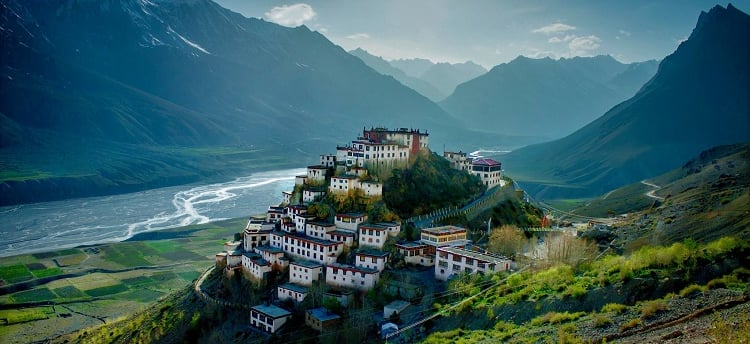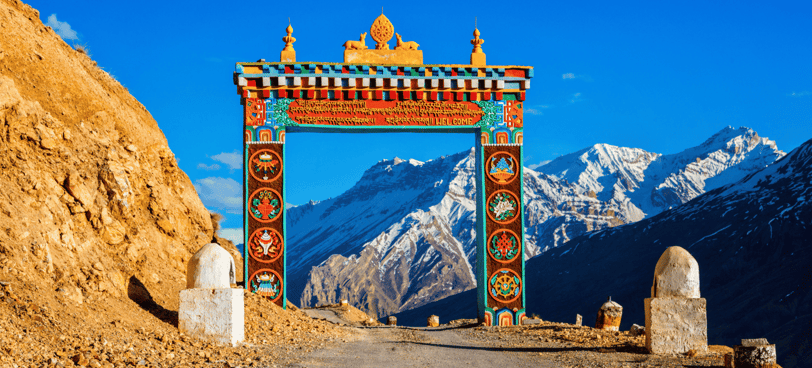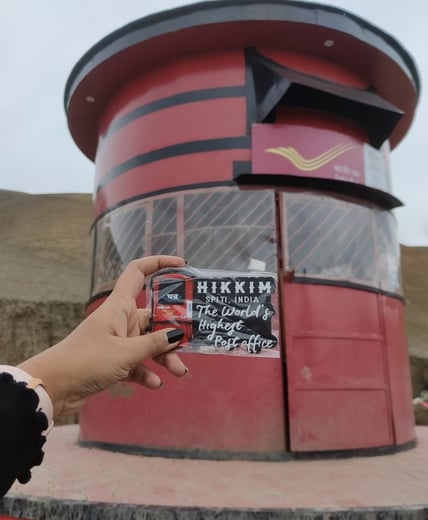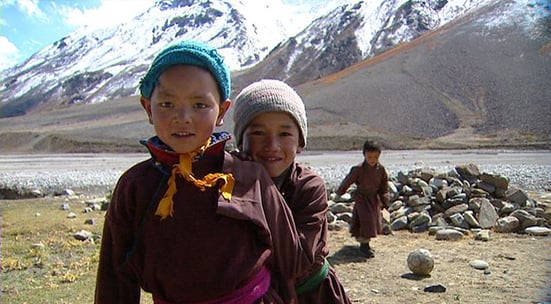Camping Under the Stars in Spiti Valley
Nestled in the rugged embrace of the Himalayas, Spiti Valley offers a surreal escape for those seeking solitude and starry nights. Camping under the stars here is a fantastic experience — mountain air, a blanket of twinkling constellations, and the raw beauty of barren peaks surrounding you. Pitch your tent along the banks of the Spiti River or near ancient monasteries, and let the silence of this high-altitude desert wash over you. Here, the night sky unveils a cosmic spectacle, making it a stargazer’s paradise. Pack warm, embrace the chill, and lose yourself in the magic of Spiti’s celestial canopy.
TRAVEL DIARIES
Marisha
4/2/20257 min read


Spiti is a high-altitude region of the Himalayas, located in the north-eastern part of the northern Indian state of Himachal Pradesh. The name "Spiti" means "The middle land", i.e. the land between Tibet and India.
I's also called "Little Tibbet". At a height of 12,500 feet above sea level, Spiti Valley takes pride in being one of the most beautiful places in the country. Every year, thousands of tourists come here including the foreigners of different coutries just to experience the calmness of Himalayas as well as the scenic beauty of The Spiti Valley. They mainly come here for the star gazing. It's heaven for star gazers. I's also the dream place for campers and adventure lovers. Not only that, this cold desert place is home to some of the most popular Buddhist monasteries and is also highly rich in Tibetan and Buddhist culture.
How to get the Spiti Valley?
Reaching Spiti valley is as exciting as the destination itself. You have the option of bus, air and road. Whatever suits you the most, you can choose. Here is the details:
By air
The nearest airport is Kullu Airport at Bhuntar, Kullu located at a distance of 245 km. The Kullu Airport is also known as Bhuntar Airport. So, from your city like Delhi, Mumbai, etc. You may take a flight to Bhuntar Airport. To reach Spiti from Kullu, you will have to either hire a cab or take the local bus.
By road
Delhi and Chandigarh are two popular spots to begin the road journey to Spiti. From your native place, you can travel to Delhi or Chandigarh via a suitable mode of transport and begin your Spiti trip from here. You may hire a cab or a local bus that runs to Spiti Valley. If you are someone who loves to ride a bike, you may also take a bike tour from Delhi to Spiti Valley.
By railways
Spiti Valley does not offer a railway station service in the city. Hence, if you wish to travel by train, you will have to take a stop at the Joginder Nagar Station or Shimla Station as these two are the closest railway stations to Spiti Valley. From here, you can hire a cab or a local bus to reach your final destination.
Best time to visit Spiti Valley
When planning a trip to Spiti, timing is very important. Summer(from April to October) is the best time to vistit the valley. The roads are open, and the weather is perfect. During this time, you can explore the valley without worrying about snow blocking the passes.
But Winters are for the brave. The valley transforms into a snowy wonderland. Temperatures drop to -20°C, and most roads are closed. Locals stay indoors, and only a few visitors dare to come.
Situated at an altitude of 12,500 feet above sea level, the picturesque valley encased by the Himalayas is an exotic destination and gem of Himachal Pradesh. Snow crest Alps, snow-carpeted pristine landscape, alpine forest, deep ravines speckled with greenery, glistening glaciers, sparkling azure rivers, splendid monasteries and quaint hamlets embellish the valley exude a vision of a mesmerising painting. The surreal beauty of the valley and the monasteries allures tourists and trekkers from all over the world.
Top places to visit in Spiti Valley
Spiti Valley is a treasure trove of stunning landscapes, ancient monasteries, and remote villages. Here's a list of must-visit places in Spiti Valley :
Kaza:
It's the central town of Spiti. Kaza is perfect base for nearby attractions. The main hightlights of Kaza are:
Local market, cafes, and a good spot to acclimatize.Key Monastery (Key Gompa):
It's a beautiful Tibbetan Monastery in Kaza region. It is the most famous and largest monastery in Spiti Valley with a resplendent Lord Buddha shrine and a treasure trove of ancient Buddhist literature, manuscripts, thangkas and murals. The monastery serves as a religious centre where the lamas receive their education and training. It's also the place where you get to see the stunning views of the Valley.
Chandratal Lake (Moon Lake):
Located at a height of 4,300 metres, Chandra Tal Lake is the most strikingly beautiful lake in Spiti Valley and the name derives from its crescent shape. ChandraTal Lake is popular with trekkers and campers for its mystic beauty, thrilling trails and brilliant night sky making it a gorgeous destination for camping. It also offers a perfect place for star gazing.
Kibber Village:
This village is one of the highest inhabited villages in the world. Kibber village is also a perfect spot for star gazing. If you're up for some adventure, wild snow leopard spotting (if you're lucky!), and cozy homestays with the friendliest locals.
Hikkim:
Hikkim is the home to the world’s highest post office, where you can literally send a postcard from the top of the world—how cool is that?! Imagine dropping a letter here and having it travel through some of the most rugged terrains before reaching its destination. It’s a tiny post office with a big legacy, run by a postmaster who braves extreme weather to keep the mail going. Don’t forget to grab a few postcards as souvenirs—you won’t find a mailing experience like this anywhere else!
Tabo Monastery:
The Tabo monastery is the oldest and most ancient monastery in India. Built-in the 10th century, it is perched on an elevated altitude of 10,000 feet above sea level in the cold desert of Tabo. Referred to as the ‘Ajanta of the Himalayas’ as the walls are adorned with mesmeric murals depicting the ancient tales of the Mahayana Buddhist Pantheon and ancient paintings just like in the Ajanta caves, it is a beautiful monastery comprising 9 temples such as ‘The Temple of the Enlightened Gods’, ‘The Buddha Maitreya’ etc. and multiple stupas. Being one of the most historically significant sites in Buddhist culture, the Archeological Survey of India has taken over the responsibility of its maintenance and preservation.
Pin Valley National Park:
Set amidst frozen streams is a beautiful Pin Valley National Park situated in the cold desert bio reserve of Spiti Valley. It is home to rare and endangered diverse species of flora and fauna. One can encounter wildlife such as Siberian ibex, Himalayan snow leopard, snowcocks, Tibetan gazelle, woolly hair, and chukar partridge amongst others. 22 rare medicinal plants have been discovered here apart from the cedar and deodar trees populating the park. Adventure seekers can also trek to the park through scenic beauty and the regal backdrop of snow-capped Alps.
Unique Culture and Traditions
The people of Spiti are its true treasure. They live simple lives in harmony with nature. Spiti is often called “Little Tibet” due to its strong influence from Tibetan Buddhism. Monasteries like Key, Tabo, and Dhankar serve as spiritual and cultural centers, housing ancient murals, scriptures, and relics. The valley follows Mahayana Buddhism, and daily life revolves around prayer rituals, monastery visits, and festivals.
Festivals in Spiti are vibrant and deeply spiritual. The Losar Festival, marking the Tibetan New Year, is celebrated with prayers, traditional dances, and feasts in February or March. Another unique celebration is the Fagli Festival, where locals wear elaborate masks and perform folk dances to welcome the new agricultural season. During the Ladarcha Fair, once a major trade fair between Spitians and Tibetan traders, locals now come together for cultural performances and community gatherings. One of the most fascinating traditions is the Devil Dance (Chham Dance), where monks dressed in colorful masks perform ritualistic dances to ward off evil spirits.
The primary language spoken in Spiti is Bhotia, a dialect of Tibetan, though many locals also understand Hindi and English, especially in tourist areas. If you're visiting, learning a few local words can make your experience even more special. A simple "Julley" can go a long way—it’s a multipurpose word that means hello, goodbye, and thank you! Another common greeting is "Tashi Delek," which means good luck or best wishes. If you want to try some local food, you might hear the words "Oma" (milk) or "Chhang" (local barley beer).
Some Interesting Facts About Spiti Valley:
If you are curious to know more about Spiti Valley and its beauty, here are some unique facts about the place:
Spiti Valley is a gorgeous snow-laden barren desert with breathtaking unadulterated beauty.
Lhalung monastery, one of the earliest monasteries founded by Rinchen Zangpo who is considered a Buddhist ‘Mahaguru’ is a popular attraction. The monastery is adorned by a complex of 9 shrines, each of which is a hub of Buddhist teachings. It is also called the Golden Temple due to the gold leaf deities kept in its shrine.
Dhankar Lake at a distance of 5km from Dhankar monastery is a spellbinding natural clear lake perched on a cliff at a height of 4,270 metres with picturesque surroundings. It can be reached by undertaking a thrilling and arduous trek expedition of an hour from the monastery.
Several villages in Spiti Valley offer captivating and exciting trek trails with mesmerising views such as Kibber, Losar, Kormik and Darcha.
Yak and Horse Safaris are the most popular and fun ways to explore the valley.
Adventurists can engage in river rafting at the Spiti River while basking in the beguiling views of the picturesque landscape.
The world’s highest village Kormik is situated in Spiti.
Travel tips:
Traveling to Spiti needs some preparation. Here are some tips:
Pack layers of warm clothes. Even summers can be cold.
Keep cash, as ATMs are rare.
Drive slow and steady. The roads are tricky.
Carry snacks and water for long drives.
Take it slow to avoid altitude sickness.
These small steps will make your trip smooth and enjoyable.
Where to stay in Spiti Valley:
Spiti Valley offers a variety of stay options, catering to different travel styles:
Homestays – Perfect for an authentic local experience with warm hospitality and homemade food. Top picks include Norling Homestay (Kaza), Tara Homestay (Langza), and Zostel Homes (Kibber & Laaza).
Guesthouses & Hotels – Ideal for those seeking comfort with good amenities. Popular choices are Hotel Sakya Abode, Deyzor Hotel (Kaza), and Snow Lion Guesthouse (Tabo).
Camping – Best for adventure lovers wanting to sleep under Spiti’s starry sky. Great campsites include Parasol Camps (Chandratal) and Nomadic Camps (Losar).
Monastery Stays – A unique spiritual experience, staying in monasteries like Key, Tabo, or Dhankar, where you can attend prayer sessions and live like a monk.
Conclusion:
Spiti Valley is more than just a destination—it’s an experience of a lifetime. From its breathtaking landscapes and ancient monasteries to its rich culture and warm hospitality, every moment here feels like a journey into a different world. Whether you're camping under the stars, exploring remote villages, or soaking in the spiritual vibes of monasteries, Spiti offers a unique blend of adventure, serenity, and tradition. If you’re seeking an escape into nature, culture, and adventure all in one, Spiti Valley is the place to be!






